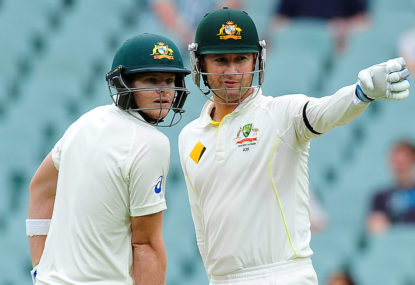WATCH: Cam Green soars with 'Go go Gadget' arms to take an IPL stunner
The Aussie needed every centimetre of his height and reach to reel that one in!

Captaincy affects different men in different ways. For some the added responsibility fires the player to ever-higher peaks of performance, while for others the burden of command crushes the skipper as effectively as a blue whale dropped on a cat’s head.
For Kim Hughes, it all ended in tears, while for Jimmy Adams it resulted in a series of recurring nightmares that continues to this day. History teaches us that for Ian Botham, the honour was a poisoned chalice, and the pressures of the job caused Australian legend Warwick Armstrong to gain six stone and hurl himself into the ocean.
The effects of captaincy are particularly pertinent to Australian cricket right now, due to the issues swirling around the Aussie World Cup squad. The squad itself contains at least six captains of various kinds.
They are: the injured patriarch of Australian cricket, Michael Clarke; his one-day deputy George Bailey; his Test understudy Steve Smith; Brad Haddin, who filled in for an injured Clarke on the last day of the Adelaide Test; Shane Watson, who in 2013 was given the captaincy for one Test as a punishment for not doing his homework; and Glenn Maxwell, who is the captain of all our hearts.
Now, all these captains in the one place are bound to cause tensions, running the risk of fracturing the fragile beauty of team unity. We would do well to heed the lessons of Pakistan, who went through a period when only former captains were eligible for selection, and proved an uninspired and disheartened side as a result.
So the question is, who is to take charge for the upcoming tournament? Should Clarke, indeed, retain the reins, despite his debilitating injury, deploying his tactical genius from behind the scenes on those occasions when his ageing body disintegrates on the dressing room floor? Should Bailey be given official control of the team? Should Smith, already having stamped his authority on the white uniforms, be allowed to do the same for the coloured? Should someone else be given the job for obscure and baffling reasons?
You could answer ‘yes’ to any of these questions and be correct. But no matter which individual is given that little (c) next to his name, there is the risk of dissatisfaction and discord among the troops, due to the snubbing of other individuals.
Therefore the answer is clear: don’t make an individual captain at all.
Am I mad? Perhaps. But there is genius in my madness. Look at the evidence: in Tests before being made captain, Clarke averages 46.97, while in matches as captain, he averages 56.59. That’s quite a discrepancy.
Now look at Smith, who as non-captain averages 46.02 and as captain averages 92.50, which even a layman like me can see is definitely a higher number.
Bailey’s captain versus non-captain figures in ODIs are fairly similar, but what cannot be denied is that in his five Tests, played as a regular member of the XI, he was underwhelming, which logically suggests that if he had been captain he would have been overwhelming, or at least whelming.
And remember Watson’s performance as captain? No? Me either, let’s keep it that way.
The point is, the verdict is in: for the modern Australian cricketer, captaincy improves performance. With this in mind, why on earth would we limit the potential of our World Cup side by giving it only one captain, when there are fifteen men in the squad ripe for improvement if given the chance to bloom?
Put simply, what Australia’s selectors must do is make everyone in the team captain.
It made Clarke a better batsman, it made Smith a better batsman, it made Bailey an excellent performer when talking to the commentators on Channel Ten‘s Big Bash League coverage, and it seems to have done wonders for Ian Chappell’s self-esteem. And think what Shane Warne might have ended up like if he had been given the Australian captaincy on a full-time basis: we don’t know, but he couldn’t be any worse.
What’s more, it will teach the fresh-faced youngsters of the Aussie squad some much-needed discipline. What better way to say, ‘Time to grow up, lads’ than to make the lads the captains?
Of course there are possible drawbacks. There may be some on-field delays as Clarke, Bailey, Smith, Haddin, Watson, David Warner, Aaron Finch, Glenn Maxwell, Mitchell Johnson, Pat Cummins and Josh Hazlewood argue over just how square fine leg should be set. But as everyone knows, healthy debate does not weaken an organisation, it strengthens it. And I believe this will only strengthen our team.
And anyway, the odd delay is certainly worth when you consider the constant stream of centuries, five-fors, spectacular run-outs and miraculous catches flowing from the bats, hands and musculoskeletal structures of our new troupe of skippers.
Just as the Dutch football team became renowned in the 1970s for its total football approach, this is an opportunity for the Australian cricket team to win fans, plaudits and trophies by the score with this innovative total captaincy strategy. I now call upon the selectors: Rod Marsh, Mark Waugh, and whoever else is one, to take the plunge and put everyone in charge.
Australian cricket needs strong leadership – and the more of it the better.